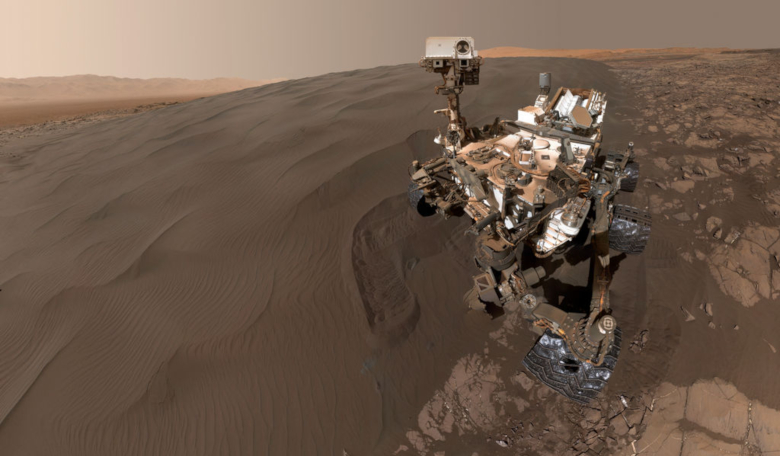Sand scooped up from the Bagnold Dunes on Mars by NASA’s Curiosity rover contains a number of organic molecules including benzoic acid, ammonia, phosphoric acid, phenol and several nitrogen-bearing molecules say scientists who have analysed the sample as part of a ‘wet chemistry’ experiment. A number of organic compounds that have yet to be identified were also found, the team add.
Since its arrival on Mars in 2012, NASA’s Curiosity rover has been exploring the ancient environments in Gale Crater in search of organic compounds, primarily using its Sample Analysis at Mars (SAM) instrument.
SAM is a suite of three instruments, including a mass spectrometer, gas chromatograph, and tunable laser spectrometer, designed to analyse gases found on Mars.
To do this, rock samples collected by the rover are slowly cooked in one of its two ovens, that can heat samples to about 1,000 degrees Celsius (1,800 degrees Fahrenheit). As the rocks begin to bake, volatile gases are liberated which then get sent to SAM’s gas chromatograph and mass spectrometer (GCMS) for identification.
So far, a number of organic molecules have been found this way using SAM, including chlorinated hydrocarbons and sulphur-bearing organics, but this technique also has a downside.
Instead of transforming straight into gases when the rock samples are heated, the molecules can decompose into simpler compounds and the true nature of the original molecule can be lost.
So Curiosity has another trick up its mechanical sleeve; ‘wet chemistry’ experiments.
Wet chemistry experiments involve “derivatising” organic molecules before they are heated, meaning that they react with other chemicals first in order to become more volatile.
By derivatising the molecules first, the compounds are more likely to enter SAM’s gas chromatograph and mass spectrometer (GCMS) without breaking down, and SAM has a better chance of detecting them.
Because this derivatisation process uses solvents of chemicals, it is called a “wet chemistry” experiment.
But, Curiosity only has nine cups containing these solvents, so only the most interesting rock samples are selected for wet chemistry experiments.
One such sample picked for analysis was collected by Curiosity during its journey across the Bagnold dune field, a 35-kilometre (22 mile) long by 1-2 km wide dune field that wraps around the northwest side of Mount Sharp.
Likely exposed to ionising radiation for millions of years, these large, active Martian sand deposits are not expected to be rich in well preserved ancient organic molecules.
However after a team headed by Maëva Millan at Georgetown University in the US, analysed results of a wet chemistry experiment conducted by Curiosity on sol 1909 of the mission in December 2017, that’s exactly what was found.
Along with chemically derivatised benzoic acid and ammonia, spectral signatures matching derivatised phosphoric acid and phenol were detected.
Although phosphine (PH3), the simplest phosphorus hydride, has been linked with the possible signs of microbial life found in Venus' atmosphere, the detection of phosphoric acid (H3PO4) in simple mineral mixtures implies that it can be easily formed from minerals including phosphorus, say the team, as such phosphoric acid is possibly the result of chemical weathering of rocks.
Several nitrogen-bearing molecules were also detected, including, amongst other things, HCN (hydrogen cyanide); isocyanate - a group of organic compounds that on Earth are used in construction products; and isocyanomethane, also known as Methyl isocyanide.
Isocyanomethane is a compound mainly used for making other molecules, specifically 5-membered heterocyclic molecules. Heterocyclic molecules include all of the nucleic acids –large biomolecules essential to all known forms of life.
As part of the research, the team also focused their search on amino acids, the building blocks of proteins, as these and other species such as amines and amides have previously been detected in Martian meteorites, but none were found, say Milan and colleagues.
But, the team’s analysis did find as many as 24 unidentified organic compounds whose spectral signature could not be conclusively assigned to a particular molecule.
So far, only a few wet chemistry experiments have been performed by Curiosity and it’s a challenging task say the team, as you need to unravel the molecular components that come from indigenous sources from those that could have been produced within the instrument itself.
These results therefore will not only help optimise future derivatisation experiments say the team, but it also helps boost the number of known molecules present in Martian samples.
The team’s paper, “Organic molecules revealed in Mars’s Bagnold Dunes by Curiosity’s derivatization experiment,” can be found here.











